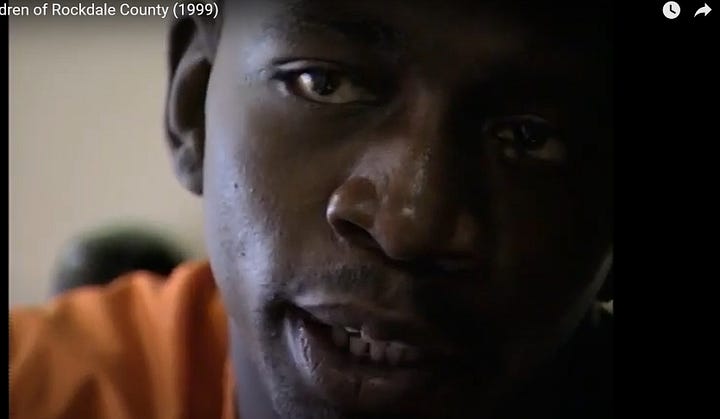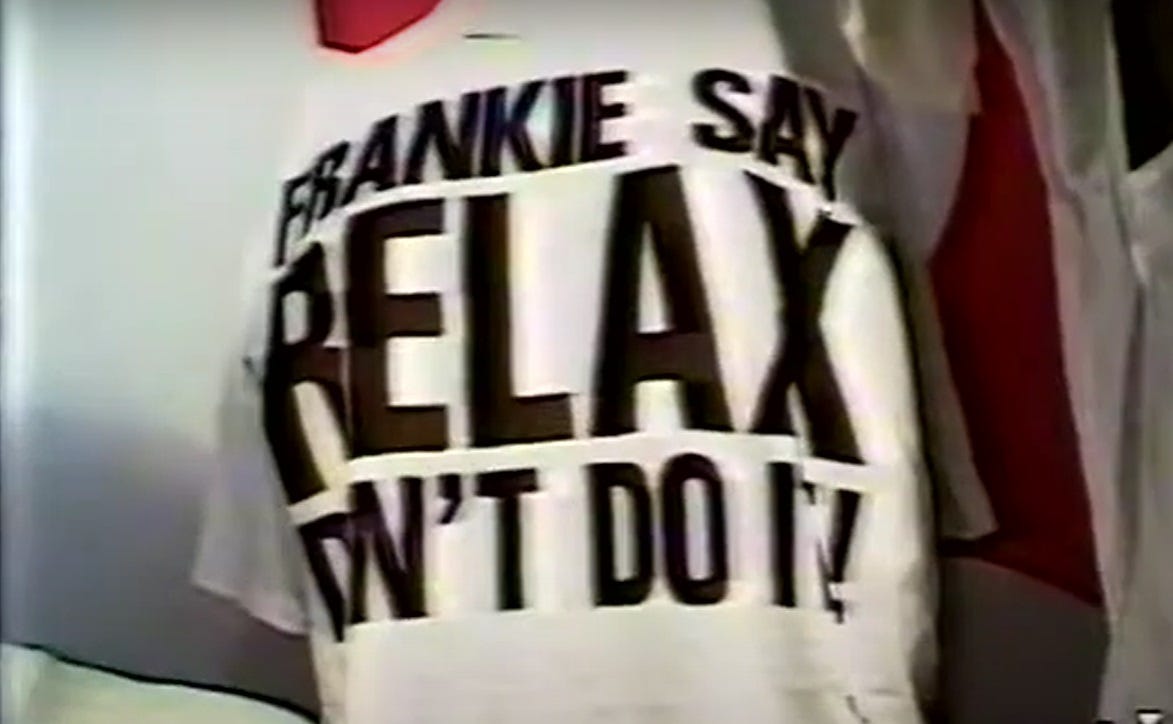American Degeneracy Laid Bare
Examining the Documentary “The Lost Children of Rockdale County” on Its 25th Anniversary
Next month will mark the 25th Anniversary of the airing of a PBS Frontline documentary called “The Lost Children of Rockdale County,” which originally aired on October 19, 1999. The documentary concerns the outbreak of syphilis among teens and even preteens as young as twelve in Rockdale County, Georgia, a suburban area East of Atlanta. The film explains how public officials tracked syphilis and other venereal diseases among patients, tracing sexual contact from those who tested positive for syphilis or other venereal disease to other persons these patients had sexual contact with. The investigation uncovered hyper-promiscuity of the most profligate and debased sort. While shocking most “normies” then and now, the sordid details are of little surprise to those more aware of what is actually happening and has been happening in this country for some time. The investigation revealed that teens and preteens, especially white suburban girls, were engaging in extremely promiscuous behavior, involving not just a quick succession of sexual partners weekend to weekend or night to night, but involving simultaneous sex partners: that is, group sex. The documentary describes what happened as follows:
It was not uncommon, when all the young people would get together, to engage in group sex. There was group sex going on in terms of one guy having sex with one of the girls, and then the next guy having sex with the same girl. There was group sex going on in terms of one girl having sex with multiple male partners at the same time, multiple females having sex with each other at the same time.
While this did involve many of their white male peers of the same or slightly older age group, there was also a pronounced interracial aspect to the sordid sexual profligacy, where the girls copulated not just with whites, but blacks as well, and did so not as an isolated incident, but as a repeated, observable trend.
As the narrator recounts, “Most of the girls were white, but the boys were racially mixed.’ Refusing to condemn outright, the narrator simply describes this as “yet another boundary the kids chose to cross.” An obnoxious talking-head, Professor Claire Sterk from The School of Public Health at Emory University, then expounds further, with tone and language that are not exactly disapproving or admonitory:
There is a taboo that has not disappeared regarding sexual activity between African-American men and white women. Here we're talking about white adolescents. So in many ways, what was happening here was that the girls not only were challenging community norms by being sexually active, but were challenging those even further by engaging, at least part of the time, in sexual activity with African-American males.
The ugly hag practically condones such behavior. “Challenging norms” is not only a euphemism, it is a loaded term with an unmistakably positive connotation. Think for example of the term “challenger” in relation to championship bouts, or the doomed space shuttle named the “Challenger.” In its history, the Royal Navy has named eight vessels “HMS Challenger.”
Claire Sterk: by not condemning such degeneracy, she is in fact condoning it.
In its examination of what happened and why, the documentary features a number of interviews of young people who lived in Rockdale County during the time of the outbreak, some of whom were participants, and others who were just aware of, but claim to not have done such things themselves—to what extent the latter are entirely honest is up to each individual viewer to decide. There are also interviews with parents, including one boomer mother, a divorcee, who went to business school to support herself and her daughter in a broken, single-mother home. The two rarely ate dinner together, as the mother went up to her bedroom to work on excel sheets while eating.
One scene is particularly noteworthy, in which a reporter interviews three blonde girls, age 14, telling the interviewer about what their peers do, and the music they listen to. When asked what music they like, they all answer, at once, “rap.” The “music,” if one can call it that, is so profane, so vulgar, it would have made a sailor blush in generations passed. The interviewer asks them to recite the lyrics of a song they like. In unison, they quickly recite lines from a song called “Luv In Ya Mouth.”[1] The lyrics from this charming little ditty, as recounted by the three high school freshmen, read as follows:
I take 3 little bitches and I put 'em in a line
I take 4, 5 ,6 and blow 'dem hoes mine
It'll take 1 more before I go for mine
Then 7 bitches get fucked at the same time
Ichi ni san shi, she can suck a ding dong
All day, all night, all evenin' long
She said she never done it, she said she never tried
She's sittin' there tellin' her mother fuckin' lie
Now, how many licks does it take to make my dick split?
Well, not many licks if the bitch is a good trick
Now, any niggas can talk to a bitch and get the bitch to fuck
But how many niggas can talk to a bitch
And get they dick sucked?
Like me, a pimp that you never saw.Now how do u say "ménage à trois?"
The interviewer exclaims “that’s about group sex,” to which the girls respond “yeah.”
“Is that something anybody does around here,” the interviewer asks, to which one girl responds “uh huh.” “Lots of people” replies another. “A lot of people” replies the third. Perhaps most disturbing of all, one of the girls explains to the interviewer how promiscuous many of her peers are by demonstrating exchange of sex partners with stuffed animals more appropriate for elementary school children or younger. Another demonstrates how a woman, or rather barely adolescent girl, gets double-teamed, again using childish stuffed animals as props.
Fun with stuffies. The girl in the lavender shirt demonstrates a male on female on male sexual position. The image on the left depicts a white and golden brown stuffed animal, representing the teen girl. The image on the right depicts the second male engaging the teen girl from the opposite direction. The alligator seems to be facing the wrong way. Note the girls are all smiles in these screenshots.
This segment, more than any other moment in this documentary, demonstrates the importance of the cultural milieu that envelops and shapes the individual to an incalculable degree. Neither young people nor anyone can divine such proclivities and inclinations in a vacuum, by themselves. These ideas, to the extent one can call them ideas, these things are implanted in their minds by the cultural milieu that envelops them and envelops us all. These girls like rap music because they came of age in the suburban Atlanta area in the 90s, whereas if they grew up in the 20s, they would probably like hot jazz music. If they were raised on an Amish plantation their likes and preferences would similarly be defined by that cultural milieu.
The predominant factor of culture also explains one of the figures interviewed, “DJ,” who was one of the ringleaders behind the debauchery. DJ is a rich, affluent white kid; his parents were well-off, although he was living with his god-father, a well-to do business man, after his parents divorced. Both his parents and his god-father seem to have given him a blank check for a spending allowance. And how did he use that money? One of the blacks interviewed, who was interviewed from jail, stated for all intents and purposes DJ paid them, the blacks, to be his friend:
D.J.: Miguel was- he was like my big brother. He was like my older brother. At the time, he was the most- I don't know. He was- everyone was terrified of him. So for him to be my big brother, for everybody to be then terrified of me.
MIGUEL: He was a younger kid. He was about 13, and I was about 17, 18. And usually, you know, an older kid wouldn't hang around nobody that young. But D.J. started- just started giving everybody money just to be a friend. And back then, I didn't have no job or nothing, and he would give me this money. And the money was- you know, I ain't going to lie, the money was good. He's my best friend.
Did D.J. and others conjure this notion of low-life thugs from the black undertow as having high social status in contemporary teen society? NO!—such ideas were implanted in their brains by the same cultural milieu that has rendered rap music so popular for several generations of whites.


D.J, and his friend, black Miguel, two prominent players in the debauchery documented in this film.
There has of course been much discussion about this documentary and the social ills it depicts. As with so many other things regarding the dissolute state of culture and particularly young culture, much of the focus of this discussion points the proverbial finger at recalcitrant parenting that is negligent at best, abusive at worst. Parenting is a factor, but it has been demonstrated time and again that no parent, no matter how well-meaning or diligent, can shield adolescent or grown children from the nefarious elements in the culture that engulfs us all. Parenting is part of the solution, but parenting alone cannot solve these problems alone. Something drastic—something radical—needs to be done about the culture and those elements that have not just allowed these dissolute elements into the stream of culture, but have actively promoted and condoned this very poison.
Some 25 years have gone by, and by most all accounts things have only worsened. The country has had three Republican presidential terms in the White House and a number of prominent figureheads in professional conservative punditry, and few if any have talked about such things, let alone come up with an actual solution to these and other social ills. Some assure the public that in the end, the “marketplace of ideas” will win out, that this is a temporary problem; to the contrary, these and other problems have been going on since the early 90s, the early 60s actually if one includes the profligacy and decadence that typified the boomer generation. And there is no end in sight.
A key, contributory factor to these and other troubles is that most mainstream Republicans and establishment conservative figures hold matters of culture in quiet if not outright contempt. And so many of a mainstream conservative persuasion wonder why cultural Marxism and other leftist rabble have achieved seemingly intractable dominance in most cultural institutions and centers of power for decades.
But these troubles go much deeper than the intrinsic inadequacy of mainstream conservatism. This phenomenon in particular—as well as the great majority of modern culture and society—calls into question the most deeply held norms about democracy and what is perceived to be individual liberty. Indeed, that the culture has been allowed to devolve to such an appalling degree calls into question whether the First Amendment itself, either as part of the highest law in the land or as a deep-seated cultural value, is really a good idea at all.
At the time when the cultural and sociological antecedents underlying this scandal were burgeoning, Tipper Gore famously decried vulgarity and profanity in some popular music. Her concerns were legitimate, but her response could not have been more counterproductive. That solution was to put labels on compact discs, tapes, and vinyl records with the caption “explicit lyrics; parental advisory.” This was done without restricting sale or access in any way. The recording industry would be hard pressed to find a better way to draw greater interest from teenage audiences than this. The music industry feigned outrage with crocodile tears, falsely decrying it as censorship, which far too many bought into. By tapping into American sensibilities about “freedom of speech,” the recording industry was actually bolstered by all this, rendering Tipper Gore’s initiative an even greater failure. There have been other instances of the so-called “Streisand Effect,” including the BBC “banning” “God Save the Queen” by The Sex Pistols and “Relax” by Frankie Goes to Hollywood. The BBC never banned either, but simply refused to broadcast these songs over the airwaves. “Relax” was always available at record stores, the BBC just indicated, by way of a highly publicized announcement (reaching everyone in British society) that “Relax” would no longer be played on the airwaves, because of how highly suggestive the lyrics are of certain homosexual sex acts.[2] Sales skyrocketed, and the “ban” lasted less than a week. Soon “Frankie” themed t-shirts would become a fad that overtook both Great Britain and the United States in 1985.
A still shot from a BBC news production on the Frankie Say craze that overtook the Anglosphere in 1985 shortly after the limp-wristed “ban.” Broadcasting that something is banned without actually banning only increases its notoriety and popularity.
Compare and contrast these counterproductive measures with how Germany for example has dealt with “materials harmful to minors.” That term is not in reference to pornography or torture porn in films of course, things that actually are harmful to minors and adults alike, but music and other media that convey, or could be interpreted to convey, “far-right” ideas, sympathy or condonement with either national socialism or even the Germans who lived during that time. The German government does not put a label on compact discs, records, and the like brandishing a recording as neo-Nazi or far-right. They ban the sale of such materials outright, making it illegal to sell (but not possess) such media. Neither the German government nor state-owned media announce to millions that a particular disfavored artist, album, or song will not be played on the airwaves, thereby publicizing such materials to the public. They quietly prevent the broadcast, and disseminate lists of materials deemed to be “harmful to minors” to law enforcement and other agencies, as those agencies then use (or did use) those lists to audit what was sold in record stores back when those existed. As far as this author is aware, those lists are not available to the public.[3] Nor is it the case the that the German government exercises this power sparingly, as the Bundesrespublik banned two Death in June, Brown Book and Roseclouds of Holocaust, the content of which is famously cryptic and ambivalent. Whereas Tipper Gore’s initiative to put explicit advisory labels on recordings was an absolute farce, these efforts have been incredibly effective in curbing the rise of “far-right extremism” in Germany and elsewhere in Europe, and helped curb a short-lived spurt of such nationalist sentiment that occurred briefly in the early 90s after Reunification. To be clear, the German government is entirely wrong about what it censors, but the tactics it uses have been remarkably effective in curbing and curtailing cultural trends it wrongly finds to be anathema. It is the motivations of the Bundesrepublik that are repugnant, the tactics are sound, and if the right ever achieves political and cultural power necessary to implement such measures, similar policies and more must absolutely be implemented to further our righteous ends.
Such measures would be impossible in America right now, although we are just two Supreme Court justices from a majority in league with Ketanji Brown Jackson, Elena Kagan, and Sonia Sotomayor who would gladly carve out an exception to First Amendment protection for so-called hate speech; they would do so by judicial fiat, without any basis in either the text or history of the Constitution or legal precedent, just as they did in Roe v Wade and Obergefell v Hodges. In relation to the sort of filth like that recited by barely pubescent blonde girls in the scene above, First Amendment jurisprudence seems too far gone, so that proper remedies will never be available under this current system, notwithstanding other problems including mass media conglomerates wielded by a hostile elite, a diminishing white demographic, and so on. But it did not have to be that way. It is highly doubtful, indeed it defies all credulity, to suppose that the Framers intended the First Amendment to protect obscenity and profanity that conveys no meaningful message of a political, ideological, or intellectual nature. Indeed, to this day obscenity is still not technically protected by the First Amendment. The problem is that the Miller test is phrased in terms of contemporary community standards. Because tolerating deviant, anti-social, or undesirable behavior defines deviancy down, this means the failure to respond immediately and robustly will render pornography or other such material in conformance with “contemporary community standards.”[4]
In Slouching Towards Gomorrah, as well as in different public speaking engagements, the late judge Robert Bork endorsed censorship. In this panel discussion with Camille Paglia, he even quoted a woman who works with single teen mothers, who stated that the most effective way to deal with “illegitimacy”—that is children born out of wedlock—would be to “shoot Madonna.” With some flippancy, he half-heartedly disclaims “that may be a little extreme, but you see her point.” Of course, in comparison to the modern age and even the music recounted in this documentary, Madonna seems so incredibly quaint. A person could play “Get in the Groove” in front of his grandmother and not cause too much of a stir. It is also of note this panel discussion aired in 1995, several years before this documentary aired and either just before or concurrent with the underlying events covered in Lost Children, namely widespread hyper-promiscuity and an outbreak of syphilis other venereal diseases. Of course, this documentary does not really concern the problems of children born out of wedlock or even teen pregnancy, but white teen girls and even preteens getting railed by whites and blacks. If anything, Bork and others seem to have underestimated how bad things were.
Setting aside the possibility of state action, imagine if those of a “conservative” mindset were instead inclined to a much more radical, dynamic persuasion, compelling them to respond in a much more robust manner and apply some sort of extra-legal sanctions to stigmatize or deter this filth. Were there any protests in front of record stores or MTV corporate headquarters over the likes of 2 Live Crew or Naughty by Nature? People are rightly contemptuous of the left, but the leftist pigs get some things right, namely they do not tolerate what they wrongly find to be morally repugnant. During the BLM riots, they tore down statues they found objectionable, and have before and since demanded the systemic removal and obliteration of monuments as they see fit, in accordance with their sordid, twisted moral conviction. Unlike the milquetoast opposition that claims to be against leftism, leftists act on their moral conviction. They are utterly wrong about what they find objectionable, but it is plainly idiotic to conflate tactics with motivations. Imagine if those who object to “music” like “Luv in Ya Mouth” or even “O.P.P. (Yeah You Know Me) were similarly uncompromising in their intolerance of this? Imagine if there were a threatening and intimidating presence of large, angry, muscular white men at record stores and the like deterring the sale or distribution of rap music to white teens or anyone else; imagine an intimidating and threatening presence similar to that of football games in Europe where people are deterred from wearing a visiting team’s colors in the wrong section or getting too close to the block of ultra fans to film?
The bible teaches that one will know a tree by the fruit it bears.[5] We have seen the fruits born by unfettered free speech, utterly removed and foreign to what the framers envisioned. We also see the fruits born by the supposed “free marketplace of ideas.” However readers come down on these suggested remedies, one thing is clear—establishment conservatism has proven itself yet again utterly ineffectual and useless as a remedy to these and all other societal ills: a poisonous tree utterly beyond redemption. 25 years have gone by, and things have only worsened. Now, not only are they listening to rap music in which some blackie blathers on about how some Asian whore can “can suck a ding dong /All day, all night, all evenin' long,” youths are exposed to internet porn and other harmful material, with many indications that the saturation in pornography has rendered many young people asexual.[6] And mainstream conservatism hardly bats an eye. And of course none of the fuddy-duddy types would dare mention a word about the interracial aspect to so much of this, which is one of the most morally repugnant elements if not the most morally repugnant element to this entire sociological and cultural phenomenon. One of the most tired, boring, and unoriginal quips in modern life is the adage, wrongly attributed to Voltaire, that “I disapprove of what you say, but I will defend to the death your right to say it.” A far more enlightened view is “I stand against what they say and do with every fiber of my being, and, when the time comes, I will, if necessary, fight to the death to prevent them from destroying our culture and polluting the minds of our youth.” Quaint notions about “free speech” and “our democracy” be damned to hell, this will not be tolerated—that is the radical ethos that can save Europe and the West.
PLEASE NOTE: Readers who appreciate the inisght and perspective set forth in this treatise are urged to consider offering a paid subscription or even a founding member subscription, provided such expenditures are not unduly burdensome. Readers who enjoyed this article and found it informative and insightful are also encouraged to signify their favor for this and other writings by clicking on the “like emoji,” as well as sharing this and other articles to those who would find this and other essays and articles interesting, insightful, or provocative. The like emoji or lack thereof is a greater factor than it should be that readers unfamiliar with an author or publciation use to decide whether to read any particular piece or not.
Follow Richard Parker on twitter (or X if one prefers) (@)astheravencalls.com. Remove the parentheses, which were inserted to avoid conflict with Substack’s own handle system.
[1] The song was not identified as such by the interviewer or the producers, but was ascertained by this author.
[2] During my childhood in the 80s, I was blissfully unaware of what this song was really about. To an adult, the meaning of the lyrics are unmistakable, and yet they seem so quaint in comparison to the lyrics recounted here or as well as those by many other rap “artists.”
[3] My understanding is that a German citizen can go, in person, and ask to see the list. But that list cannot be reproduced. It is unclear whether a person can go there to peruse the entire list, or simply inquire about a particular artist, album, or song. My impression is that the latter is the case.
[4] See for example the jury trial recounted in this article. In it, the jury acquitted defendant Larry Peterman in a matter of minutes because it was shown people in Provo, Utah, consumed porn. Part of this was established by viewing habits of guests in hotels. People who stay in hotels are of course generally travelers visiting from elsewhere.
[5] Matthew 7:!5-20/ This author of course is an atheist, with a fondness for the philosophy of religion found in Odinism. Even so there is wisdom to be found in some passages of the Bible.
[6] See generally Abigail Shrier’s Irreversible Damage.








Thanks for the comp Richard. You really stumbled on an eye popping documentary that I’m only able to watch in small chunks due to a mix of secondhand mortification and just ‘eww’.
This reminds me of a girl I knew in junior high that got mixed up in a group of boys from schools many towns over. Pretty much identical situation, being passed around in a room of older black dudes doing stuff that was…just like this, what a way to end your childhood at 14 years old. I was horrified. Our neighborhood just wasn’t like that. Sex was for mysterious college kids. But she was like these girls, kinda dim, desperate for something.
I’ll wince my way through this doc; I think I’m picking up what you’re laying down.